25 Jun 2010
An Inside View on the 2010 Transition Network conference, by Sophy Banks
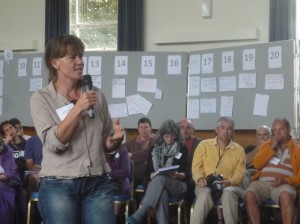 Many of those who attended the recent Transition Network conference remarked on how well facilitated the event was, and on the group process run on the Sunday. Although the event was designed to feel as self-organised as possible, there was a great deal of intentional design behind the event, much of which was the work of Sophy Banks (see left). In the following piece, Sophy explains the thinking behind how the event was facilitated, and offers tips for those wanting to organise similar events.
Many of those who attended the recent Transition Network conference remarked on how well facilitated the event was, and on the group process run on the Sunday. Although the event was designed to feel as self-organised as possible, there was a great deal of intentional design behind the event, much of which was the work of Sophy Banks (see left). In the following piece, Sophy explains the thinking behind how the event was facilitated, and offers tips for those wanting to organise similar events.
“If you’ve had enough of the Transition Conference at Seale Hayne – sorry! I’ve written this for those interested in the process of designing and running the event, particularly because what happened gave such an opportunity to explore what happens when something shocking lands in our communities and really shakes people up. In this post I’ll talk about what I’ve learnt – in particular how key it is to be able to marry the practical, outer, doing side of Transition, the factual knowledge of what’s happening, the ability to express and hold strong feelings, and then to reflect and make a deeper meaning from what’s happened. Holding this conference became a powerful job of weaving together these different qualities and skills in a frame of mutual respect and trust, with an amazing group of over three hundred people who brought all the different elements that were needed. The underlying intention for the conference was recognise the strength that comes with inclusion and diversity, and learning how to handle challenges and conflict – and we kind of got more than we bargained for!
Designing the Fourth Transition Conference
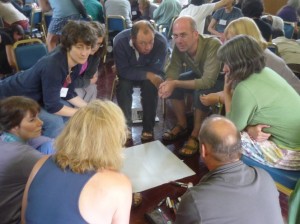 The fourth Transition conference finished a week ago in bright sunshine in South Devon. More than 300 people attended over three days, coming from just down the road and from overseas – Ireland, France, Brazil, Australia, US, and many other countries were represented.
The fourth Transition conference finished a week ago in bright sunshine in South Devon. More than 300 people attended over three days, coming from just down the road and from overseas – Ireland, France, Brazil, Australia, US, and many other countries were represented.
My role in the conference team is to get an overall conference programme that will be interesting, varied, and useful for the Transition movement. This means creating lots of spaces where people get to meet each other, with interesting questions or themes, a good range of workshops, social time and other activities. While the conference runs I usually hold one or two pieces of creative or deepening processes that I’ve contributed to the programme, and share with the team responsibility for responding to anything that occurs during the event.
It felt important in the design of this year’s event to include the fact that Transition has been going for four years – and that the wider context around us has moved on since we started back in 2006. I wanted there to be a journey in the flow of the three days, so that as well as sharing information and meeting people, having fun and gathering inspiration, there would be an element of deepening together, a sense of building trust and engaging with something challenging.
This was reflected in a number of new elements.
- People were invited to form “Home Groups” at the start of the conference – about 6 people who get to know each other at the start, and meet fixed times throughout the three days, as well as meeting informally if they want to at other times.
- We scheduled a longer, 3 hour workshop session to give a chance to go deeper into topics.
- We included a session where the whole conference came together in their “Home Groups” to explore thoughts and feelings of what is really coming in the next one, five and ten years into the future. This was not a “positive visioning” session such as we often do in transition, but a wider ranging naming of what we fear as well as hope for, what could be really dangerous or challenging as well as what might not change at all, and what might transform to something wonderful.
The ‘Stoneleigh Factor’
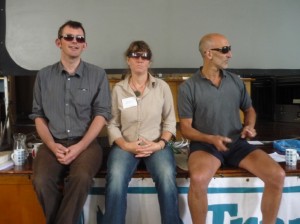
Sophy, Peter and Rob find a novel way to show people what Lost Property has been handed in....
The wildcard in the conference design was the inclusion of “Stoneleigh”, a American researcher who blogs widely in the States and is a very respected voice on the economic situation. She looks at OECD countries’ debt, GDP, and the rest of the global financial system, and predicts that this system will collapse in the near future – within 6 – 18 months. I didn’t know much about her, but others in the team felt she would bring something very valuable, and so we included a talk by her that we had to schedule at the same time as open space on the first afternoon because this was the only slot she could make.
The conference opened pretty much according to plan – with mappings showing a much greater variation in “how far on are we?” across all population sizes. The age spectrum included more young people. After forming home groups and setting up the open space sessions we broke into interest groups – another piece we thought would be relevant as many more transition projects have formed theme groups than in previous years.
The first we realised of the wildcard taking effect was that the first open space session – with Stoneleigh running parallel – looked pretty empty. Last year in Battersea we set up 25 tables for open space conversations, and added a further 10 – giving an average of about 10 people per table. The main hall was packed, buzzing, overflowing with people and movement and the hum of intense discussion. This year in the main hall a few tables had a group discussion going, many were just two or three people.
At the end of the afternoon I talked with some of those who had been to the Stoneleigh talk, who looked in a state of shock. One was wondering what to do with a mortgage and children to feed. In fact over 100 people – about a third of the conference – had attended Stoneleigh’s session, which had gone on longer than expected. Shaun has already written something about the content – the scenarios she predicts, and the subsequent advice. The impact of the information on many of those listening was substantial – perhaps a similar experience to the “peak oil” moment that we know well in Transition.
The evening progressed – England scored a terrible own goal. There was a great Open Mike session with many people performing. At breakfast the next day the conference team met and discussed what to do. (Obviously we couldn’t do anything about the England football team, but we did feel a need to respond to the impact of Stoneleigh.) We already had the Future Context process (see below) planned for the morning which would give people a chance to talk about what they saw coming in the future, and several sessions after that would give people places to take explore their feelings or other responses, so we decided to stay with the format we had and see what happened.
Exploring the Future Context of Transition – a Process for 300 people
It’s an interesting challenge to design a process for over 300 people which allows for deep reflection, as well as something creative, to include something other than heady thinking and talking. We were adapting a piece from the last Transition Network Awaydays – exploring what we really believe the future context for Transition will be. So in the Great Hall everyone sat in their Home Groups with three sheets of flip chart paper, and were invited to reflect inwardly on what is already happening in communities, countries, families.. how shifts in our financial, ecological, social systems might change the landscape of our world one year ahead… what might be forming anew, continuing or evolving, and what might be breaking down or going through rapid change. There was time to talk in the small groups about images, ideas, feelings from the reflection. And then silence in which the group captured these possibilities for how the world around us will look one year from now in images and words on the paper. A recording of this session is available here.
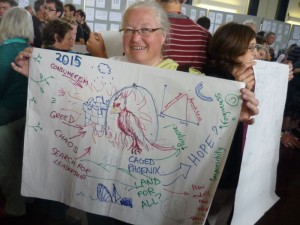 We repeated the same process for five years ahead, and then ten years, collecting up the art works at the end of each. To finish we created an instant “Art Exhibition” of the images – clearing the space in the hall and inviting some to become Art Stands, holding up the pictures in small groups in time zones for 1, 5 and 10 years into the future. Others could wander through the exhibition alone or in pairs, reflecting on what they saw. The hall soon started to sound remarkably like an art gallery, with soft murmuring conversations, some art stands revolving to display their work better, and swapping with the viewers so they too could get a sense of what the different visions of the years ahead were.
We repeated the same process for five years ahead, and then ten years, collecting up the art works at the end of each. To finish we created an instant “Art Exhibition” of the images – clearing the space in the hall and inviting some to become Art Stands, holding up the pictures in small groups in time zones for 1, 5 and 10 years into the future. Others could wander through the exhibition alone or in pairs, reflecting on what they saw. The hall soon started to sound remarkably like an art gallery, with soft murmuring conversations, some art stands revolving to display their work better, and swapping with the viewers so they too could get a sense of what the different visions of the years ahead were.
Our final piece was to invite short reflections from people in each time zone – what common themes do you see here? And how are you feeling, seeing these? You can see all the images created here.
Many of the images showed mixtures of things falling apart and new possibilities emerging, especially after five years. For one group the journey was a lot of grief in five years as old ways were lost, and then becoming peaceful as we got to ten years’ time. Many had extreme and polarised energies represented – breakdown, chaos, conflict as well as new hope – stronger, healthier, more connected communities emerging. Transition often appears as a seed below the ground while power politics plays out above. The process took a little longer than we had anticipated, but the feeling in the room was of a lot of interest and engagement despite some frustrations and a bit of discomfort with the limited space.
Workshops to Follow the Process
In the afternoon we moved to another variation on previous conferences – workshops that lasted three hours, rather than the 1½ that we have had before. Several were specifically included to be places to continue to work with anything that had come up in the large group session, (though I think we could have done more to signpost them clearly).
These included –
- Somewhere to express your own, and witness others’ feelings (a Work that Reconnects “Truth Mandala”),
- To explore more creatively Stories for Transition – using Storytelling as a way of working.
- Workshops on Diversity, on Community and Conflict, and on Inner Transition – all pieces of building the inner structures that can help a community cope with the fall out of shocks – whether they are economic, physical, or emotional.
- For those who wanted practical support for the Transition process we included sessions on Holding Good Meetings, the Energy Descent process.
- And for those wanting to get on with building the business, organisations and systems we will need to create there were sessions on Working with Business, Local Food, Social Entrepreneurship, Local currencies. There were also visits to projects in Totnes and Occombe farm to see some pieces of the resilient future already up and running.
Feedback and Conference Team Reflection
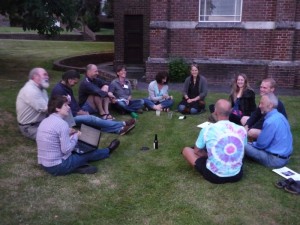
First conference team meeting on the Friday evening...
As the conference progressed we had different bits of feedback about how participants were doing – some reported strong feelings and the need to have a space to specifically address these. Others expressed surprise that the information had such an impact – surely people working in transition are aware of the vulnerability of our systems, and ready to welcome their collapse?
In the conference team we reflected on the contrast between holding the wider view – that we need the old systems to weaken and give way to the new, which might welcome information about their imminent demise – and the immediate personal fear of losing the security associated with savings, pension, home, job. Allowing these to exist side by side, and accepting that as people we can move from the expansion and acceptance of one to the contraction and fear of the other from moment to moment is part of the job of leadership or the holding role in groups and projects such as Transition. This gets us to the territory where we really need the insights of psychological or wisdom traditions to understand, for example, how these views are held in different parts of our psyche, and can co exist despite the apparent contradiction. So we can be genuine in our belief in the need for the collapse and present in our fear for the safety of ourselves and our children when it comes.
Another polarisation that seems to be common in Transition initiatives is between speed and slowness as a response. This might emerge into voices that say things like:
| We need to act and we must ACT NOW!
Don’t slow me down! I need to get on with things! |
SLOW DOWN! We need to take time to absorb the information and feel our response, not just act out of panic.
Don’t push me to go fast – going too fast is what got us here! |
This polarity often matches up with people who are interested in doing, practical actions, and people interested in inner work. Both have a healthy important aspect, and on each side is a danger that is good to avoid. These might be simplified to something like this:
| ACT NOW! | SLOW DOWN! | |
| Healthy | “When I hear about collapse I get more determined and want to act. It fires me up” | “When I really feel my fear (or grief, or despair) I reach new understandings of what I feel and then I act from a much deeper sense of connection and care for the world.” |
| Unhealthy | “I can’t bear to sit with feelings, or uncertainty so I’ll keep busy with doing. Underneath all my activity I may be terrified, angry, shut down.. But I don’t want to feel any of that.” | “The system is so powerful I’m afraid that if we act we still won’t be enough – better not to try”. |
I was interested that this dynamic came up in the workshop on Community and Conflict – as it did in another workshop recently exploring conflict in Transition. I’m curious about how widespread it is in Transition groups.
There are many other responses – some that I’ve heard include:
- Someone should have told me! Why wasn’t I informed? ..
- Surely we all know about this already, why all the fuss?
- Some of us never benefited from decent incomes, mortgages, pensions, paying for the kids’ education. What about us? Why should we care about those who are losing out now?..
- If we focus on negative ideas about the future we’ll just make them happen..
- We should welcome the breakdown of this destructive economic system – why would anyone be scared of it?..
I’m not suggesting answers to any of these, or that any are true or otherwise, rather that the job of the facilitator is to let these different positions surface and speak. If emotions are felt and expressed they pass; if they are shut down they will go underground and emerge in other forms – sometimes as blame or conflict in a group; sometimes as depression or stagnation, and in other more or less useful ways.
Expressing feelings and moving to new realisations
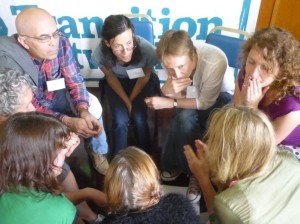 The first place where some of the depth of feeling was expressed was in the Work that Reconnects workshop held by Hilary Prentice and Toni Spencer. This included a Truth Mandala, a practice from Joanna Macy’s work, which gives a structure that supports people to speak and feel their feelings – fear, grief, anger and sense of not knowing, of hopelessness.. Seventeen people attended this, an even balance of men and women, bringing feelings about many things – ranging from the very personal through oceans and oil, what the future holds for young men and masculinity and much more.
The first place where some of the depth of feeling was expressed was in the Work that Reconnects workshop held by Hilary Prentice and Toni Spencer. This included a Truth Mandala, a practice from Joanna Macy’s work, which gives a structure that supports people to speak and feel their feelings – fear, grief, anger and sense of not knowing, of hopelessness.. Seventeen people attended this, an even balance of men and women, bringing feelings about many things – ranging from the very personal through oceans and oil, what the future holds for young men and masculinity and much more.
“One repeated theme as people held the stick for anger, was grief at our own feelings of impotence, and a recognition of the pull to ‘beat people with the stick’ of transition and of the urgency of the situation, and the awareness coming in strongly and spontaneously that this is not the way to go; a clear arising of insight and compassion in the moment.” (from the workshop write up – see the full version on the Transition Network website).
Part of the understanding that helps to hold this process is that our feelings tell us something about what is true for us – our fear tells us about the danger we are in; our grief tells us what we care about that we are losing; our anger tells us what injustices are being committed. If we can express these we get in touch with the depth of our capacity to care, to act, to respond to the danger.
At the end of the workshop a number of people expressed feeling transformed by the process – more open to connection, more tolerant, feeling clear of things carried for years.
A Spontaneous Sharing Space
In response to requests we also added an evening session on Sunday for those wanting to talk further about the impact of the conference so far. Facilitated by Peter Lipman and Jo Hardy this was shaped into some time for feelings, and then a time for answering factual questions about the economic situation that were still unanswered. Between 30 and 40 attended, expressing many different responses to what people had been engaging with.
The most important effect of this kind of space is simply to be able to express and accept what our responses are, and that there is nothing particularly “right” or “wrong” about any of them. Having a space to explore them allows deeper insights to come into what is happening inside us – for example Peter talked about his realisation that when he explored his relationship with money he was actually finding out about his relationship with fear – that money had become the thing that promised “security” in the future, something that appears to give control over life. So when my financial security is threatened I have to meet my insecurity directly.
The other effect that a group session can bring is to recognise in what others say the pieces that are harder for me to hear – for example when someone speaks about their anger I can feel that resonate in me, though it might not be the thing I am aware of. So hearing all the pieces creates a greater sense of wholeness – in each person and in the group.
Bringing it All Together – the Closing
 We decided to focus on the job of holding the conference in the closing session, trusting that what had been most striking for us would also be of use to others. We talked about the way that what’s happening in the wider world – dealing with the unexpected, the impact of fear about economic security – comes into our projects and groups, sometimes in unexpected ways and with unexpected force. The skill in the facilitation role is not to be able to anticipate everything, or to keep the unexpected out, but to use it in a way that strengthens us all, that deepens connection and generates useful learning. In this way we use the impact of the information of coming shocks to prepare us for the shocks themselves.
We decided to focus on the job of holding the conference in the closing session, trusting that what had been most striking for us would also be of use to others. We talked about the way that what’s happening in the wider world – dealing with the unexpected, the impact of fear about economic security – comes into our projects and groups, sometimes in unexpected ways and with unexpected force. The skill in the facilitation role is not to be able to anticipate everything, or to keep the unexpected out, but to use it in a way that strengthens us all, that deepens connection and generates useful learning. In this way we use the impact of the information of coming shocks to prepare us for the shocks themselves.
One piece of feedback in the closing plenary was in the Future Context exercise a group felt that after a lot of turmoil in 5 years there came a “Sweet spot” after 10 years – where life was peaceful again. For me the roller coaster of the three days resolved to a sweet spot in our final closing – all the pieces come together to make a more complete whole which has a feeling of resolution and greater meaning.
Here are some of the learnings I’ve had, or heard others say, from what happened at the conference:
– The dynamics of the wider group come right into the facilitation team – many of the conference team talked about feeling jangled, fearful, reactive, upset, sleepless, during the three days. Knowing that this is part of the job of holding the overall process helps to not take things personally, or get stuck in the fear or upset, and not to take it out on colleagues!
– It has strengthened my appreciation of and respect for those who hold a different perspective to me – how much I need the people who really focus on the “doing” to be great at that. And how good and rich it feels when they really appreciate and respect what those of us on the “inner” side bring as well.
– I felt an enormous gratitude for the depth of awareness and experience that was present in the whole conference of over 300 people – how many of us are able to reflect on our own responses and able to help in the holding of the wider circle. Without these qualities permeating the whole conference I imagine it would have been a much rockier ride for everyone.
– From a conference participant after the closing.. “I’ve finally really understood why we need inner work as part of Transition…!”
As I sit and look out at the amazing beauty of another Devon summer day I have another familiar feeling which comes after an intense process – “What was that all about?!” Sometimes it can feel as if we’ve been in a shared trance – did we need to go through all that? How can I describe it to those who weren’t there? Is it a storm in a teacup?
I’ve been in and with groups working with many different challenging situations – and the intensity of feelings that come up of fear, conflict, scarcity, competition are often surprising when we look back from a place of calm. This is also part of the nature of the territory, and I’m glad to know enough not to dismiss the reality of how challenging those times feel when you’re in it!
I leave you with something that Peter quoted, from the Totnes Heart and Soul group (thanks to Emily Ryan) – a way of expressing one of the tensions of the times we live in. I hope you can find – within yourselves and within your project – a balance between the need for speed and the need for stillness.
“In these times we need to be able to hold a place of profound patience in the face of extreme urgency”.
Sophy Banks – Transition Network Conference Team
If you are interested in the inner dimension of Transition there is a ning site www.transitionheart.ning.com for connecting with others, or email innertransition@transitionnetwork.org to be part of a national networking project. To find out more about The Work that Reconnects see www.greatturnningtimes.com or www.joannacmacy.net.
Sophy is running a workshop which brings together the Work that Reconnects, Inner Transition, Ecopsychology and more at Sharpham House near Totnes August 27 – 30. See www.sharphamtrust.org calendar for 27 August for more information. Thanks to Mike Grenville for the photos, his full collection from the conference can be found here.
Margaret Weiner
25 Jun 3:49pm
Huge thanks for this, Sophy, especially the Heart dimensions expressed. Our Transition Des Moines (Iowa USA) group will be sharing it. It both helps understand some things that have happened and can help us prepare for whatever may come up ahead.
Mark
25 Jun 7:44pm
Is it too early to ask about next year’s conference? 🙂
Every year I have great regret that I wasn’t able to attend the conference, but with luck next year I will have flexibility in schedule that has been lacking to date.
Indeed sufficient flexibility to consider alternative means of transportation (I’m in the US). However, some brief research seems to indicate that the carbon emissions associated with taking a ship across the Atlantic are greater than that of taking a 747 (although this doesn’t account for additional forcings associated with emissions at high altitudes).
Does anyone have any perspective or alternate ideas on how to make a low-carbon trip to the UK, or should I give it up? Travel by cargo ship, perhaps?
Thanks in advance for your ideas.
And really, what a great and surprising conference it turned out to be, even from a distance.
Ben & Jean Leeman
26 Jun 9:29am
We have come from Australa to the UK but were unable to participate in this wonderful conference. However we are keen to visit Totness and learn more about TRANSITION TOWN philosophy and practice.
We are actively involved in sustainability in Melbourne and would like to learn more and share experiences. We plan to visit Totness on Monday 28 June. Is there a contact person we could phone and arrange a meeting? We are currently staying with a friend in Exeter.
MANY THANKS
Ben & Jean & Liz
Steve Hinton
26 Jun 12:30pm
(Mark) I had the same feeling – I flew in from Sweden and the only way to get the travel plans to work was to bomb down the motorway in a hire car.
I wrote a long report and brought it to my steering group and them onwards into the 1500 strong Transition community in Sweden. Through reports like Sophy’s ( many thanks Sophy!) people have felt excited and connected with the co0nfrence even if they weren’t there.
So I guess sending one person to engage a thousand might be an OK use of fossil fuel.
Personally I look forward to exploring possibilities of taking over a web meetings platform and connecting the whole conference up worldwide to groups via broadband.
No idea if it’s possible.
The other would be to hold “daughter” conferences around the world after the Devon event. That would be kind of cool too.
Mark
26 Jun 3:00pm
Steve,
The web connect option sounds like a great idea–I believe the Bioneers conference here in the States does something similiar (but of course without the challenges of being global rather than just continental).
Or the daughter conferences too!
Even while we work to build community in our neighborhoods I find I still yearn for community with like-minded Transition experimentalists around the world.
Sebastian
28 Jun 9:16pm
Very impressive article!
@Steve: in the physics community we have such a virtual network which is up to now not used for larger conferences but is excellent for meetings and even workshops. You might want to have a look at:
http://evo.caltech.edu/evoGate/
Take care! Sebastian